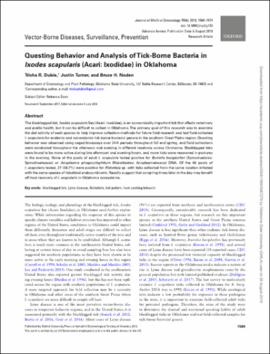| dc.contributor.author | Dubie, Trisha R. | |
| dc.contributor.author | Turner, Justin | |
| dc.contributor.author | Noden, Bruce H. | |
| dc.date.accessioned | 2022-04-12T13:31:13Z | |
| dc.date.available | 2022-04-12T13:31:13Z | |
| dc.date.issued | 2018-08-06 | |
| dc.identifier | oksd_noden_questingbehaviorandanalysis_2018 | |
| dc.identifier.citation | Dubie, T. R., Turner, J., & Noden, B. H. (2018). Questing behavior and analysis of tick-borne bacteria in Ixodes scapularis (Acari: Ixodidae) in Oklahoma. Journal of Medical Entomology, 55(6), pp. 1569-1574. https://doi.org/10.1093/jme/tjy133 | |
| dc.identifier.uri | https://hdl.handle.net/11244/335142 | |
| dc.description.abstract | The blacklegged tick, Ixodes scapularis Say (Acari: Ixodidae), is an economically important tick that affects veterinary and public health, but it can be difficult to collect in Oklahoma. The primary goal of this research was to examine the diel activity of each species to help improve collection methods for future field research and test field-collected I. scapularis for endemic and nonendemic tick-borne bacterial genera in the southern Great Plains region. Questing behavior was observed using caged bioassays over 24-h periods throughout fall and spring, and field collections were conducted throughout the afternoon and evening in different locations across Oklahoma. Blacklegged ticks were found to be more active during late afternoon and evening hours, and more ticks were recovered in pastures in the evening. None of the pools of adult I. scapularis tested positive for Borrelia burgdorferi (Spirochaetales: Spirochaetaceae) or Anaplasma phagocytophilum (Rickettsiales: Anaplasmataceae) DNA. Of the 46 pools of I. scapularis tested, 27 (58.7%) were positive for Rickettsia sp. with ticks collected from the same location infected with the same species of rickettsial endosymbionts. Results suggest that sampling times later in the day may benefit off-host recovery of I. scapularis in Oklahoma ecosystems. | |
| dc.format | application/pdf | |
| dc.language | en_US | |
| dc.publisher | Oxford University Press (OUP) | |
| dc.relation.ispartof | Journal of Medical Entomology, 55 (6) | |
| dc.relation.uri | https://www.ncbi.nlm.nih.gov/pubmed/30085216 | |
| dc.rights | This material has been previously published. In the Oklahoma State University Library's institutional repository this version is made available through the open access principles and the terms of agreement/consent between the author(s) and the publisher. The permission policy on the use, reproduction or distribution of the material falls under fair use for educational, scholarship, and research purposes. Contact Digital Resources and Discovery Services at lib-dls@okstate.edu or 405-744-9161 for further information. | |
| dc.subject.mesh | Animals | |
| dc.subject.mesh | Behavior, Animal | |
| dc.subject.mesh | Female | |
| dc.subject.mesh | Ixodes | |
| dc.subject.mesh | Male | |
| dc.subject.mesh | Oklahoma | |
| dc.title | Questing behavior and analysis of tick-borne bacteria in Ixodes scapularis (Acari: Ixodidae) in Oklahoma | |
| dc.date.updated | 2022-04-07T14:12:59Z | |
| osu.filename | oksd_noden_questingbehaviorandanalysis_2018.pdf | |
| dc.description.peerreview | Peer reviewed | |
| dc.identifier.doi | 10.1093/jme/tjy133 | |
| dc.description.department | Entomology and Plant Pathology | |
| dc.type.genre | Article | |
| dc.type.material | Text | |
| dc.subject.keywords | Vector-Borne Diseases | |
| dc.subject.keywords | Emerging Infectious Diseases | |
| dc.subject.keywords | Lyme Disease | |
| dc.subject.keywords | Infectious Diseases | |
| dc.subject.keywords | 06 Biological Sciences | |
| dc.subject.keywords | 11 Medical and Health Sciences | |
| dc.subject.keywords | Tropical Medicine | |
| dc.identifier.author | ScopusID: 37087155600 (Dubie, Trisha R.) | |
| dc.identifier.author | ScopusID: 57204451354 (Turner, J) | |
| dc.identifier.author | ORCID: 0000-0002-0096-370X (Noden, BH) | |
| dc.identifier.author | ScopusID: 6601968347 (Noden, BH) | |
